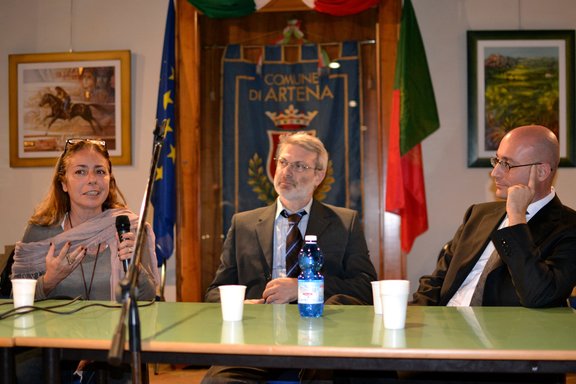
The ISB has organized a 3 days conference on Biourbanism and small towns, in order to discuss the results of one year of activity over the Italian cities of Artena, Segni and Carpineto Romano. The conference has been held in Rome, at the Faculty of Architecture, Roma Tre University, on October 18th; in Artena, on October 19th; and in Segni on the 20th.
The first day has been devoted mostly to theory and to methodology. The speakers discussed the paradigm of complexity in urbanism , and the relationship between urban sciences, social sciences, and management. Antonio Caperna (ISB) presented a general overview of what Biourbanism is, while Stefano Serafini (ISB) focused on Biourbanism’s epistemology and on the use of the grounded theory. Sherryl Muriente (Florida Atlantic University) presented her experience/project during the ISB Summer School in Artena, showing how social dimension is relevant in biourban acupuncture. Alessandro Giangrande (Roma Tre University) exposed some strategies for funding participatory projects in Biourbanism. Fulvio Forino (Dedalo 97) talked about his “bottom-up” management experience of one of the most important hospitals in Italy, and how it fits to urban contexts. Angelo Gentili (ISB) exposed the project “OpenBrew”, or how to use beer for reviving a city.
The second gathering has been the most crowded, with almost 100 people participating. The notorious Italian writer Pino Aprile introduced the conference with a touching speech about beauty, identity, and the function of places – especially small towns like Artena, Segni, and Carpineto Romano.
The “Progetto Artena” (www.progettoartena.com) has been then presented in details by Stefano Serafini and Angelo Gentili, including the continuation of the latter Artena summer school’s works by the inhabitants of Artena. Dr. Andrea Margiotti, a naturalist from Artena, exposed what kind of development one can expect in the next months at the former landfill area that was cleaned and reshaped by the students of the last July summer school. A local scholar, Pacifico Felici, revealed that that area has been already a common kitchen garden before the 2nd World War, thus confirming that the project had rediscovered a “natural” previous common use of the place. Angelo Abbate presented the European Prize for Architecture Marco Casagrande, and his book edited by the ISB. Ilaria Vitellio (Biennale of Public Spaces) and the IT expert Marco Fioretti contributed with ideas about how making small beautiful places more resilient through technology and e-culture.
Rapporteurs of the third day addressed mostly the results of the extended service design survey called “SegniSeed” – an analysis directed by the design thinker Yulia Kryazheva and Stefano Serafini, in order to figure out the identity of the city of Segni. The discussion lasted for about 3 hours. Consuelo Cenci (UGI) then warmed up the auditory, by contributing the experience of her group of young volunteers, who made a real change in the city of Colleferro. In effect, they could build out a garden from an abandoned place, after receiving a request of help from the elders of the neighborhood.
The public showed a great interest in both theory and practical activities. The bottom-up replacement of a failing economic and political system has been a recurring subject, together with self-organization, complexity, and a new era of urban challenges. Biourbanism seems to be a kind of catalyst for further action and researches in urban sciences, sociology, politics, and economics.
Dr. Serafini announced thus that the ISB is going to organize an international workshop on Biophilia and Economics, to be held in Crete, Greece, next July 2014.